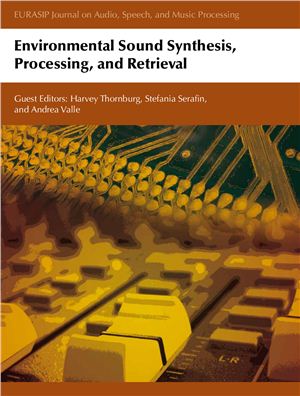EURASIP Joual on Audio, Speech, and Music Processing, 2010, -85
pp.
This special issue of the EURASIP Joual on Audio, Speech and Music Processing is dedicated to Environmental Sound Synthesis, Processing, and Retrieval. It aims at targeting the multifaceted area of research devoted to the complex relation between environment and sound, a relation that still needs to be investigated. Indeed, we are literally immersed into sound: as Handel says, Listening puts me in the world ([1], xi). In this sense, a phenomenology of listening, delving deeply into the philosophical and psychological aspects of sound perception is mandatory in order to clearly understand the specific features of auditory events with respect to other perceptual modalities. With a classic example, while vision is in some sense always exteal to our body (emphasizing the separation between subject and object in perception), sound on the contrary resonates through our body, literally embodying the information that it carries on as we vibrate through the world we are surrounded/placed into. That is, Listening is centripetal; it pulls you into the world. Looking is centrifugal, it separates you from the world ([1], xi). Even if embracing a technologically oriented perspective, these philosophical and psychological aspects are not to be omitted while researching on environmental sounds. Through a historical tendency which origins date back to 20 years ago, sound is becoming more and more relevant in our media environment. As an example, one can think about sound systems in cinema, now a standard and pervasive solution on the market. Another example is new complex, multimodal, integrated displays now pervasively built into portable devices. Not by chance, the first edition of ICAD, the Inteational Conference on Auditory Displays dates back to 1992, and from 2000 it is held on an annual basis. But, in order to effectively exploit sound, we have to avoid the risk to simply borrow principles and models from vision and to adapt them to listening, without a real understanding of specific perceptual features of the audible domain. Indeed, this applies to sound in general, but is particularly relevant for sound materials that have not been extensively studied by cultural practices with a long tradition, as it typically happens with music and speech.
Environmental Sound Synthesis, Processing, and Retrieval
Comparisons of Auditory Impressions and Auditory Imagery Associated with Onomatopoeic Representation for Environmental Sounds
Combining Superdirective Beamforming and Frequency-Domain Blind Source Separation for Highly Reverberant Signals
Development of the Database for Environmental Sound Research and Application (DESRA): Design, Functionality, and Retrieval Considerations
Ecological Acoustics Perspective for Content-Based Retrieval of Environmental Sounds,
An Ontological Framework for Retrieving Environmental Sounds Using Semantics and Acoustic Content
Physically Motivated Environmental Sound Synthesis for Virtual Worlds
Evaluating Environmental Sounds from a Presence Perspective for Virtual Reality Applications
This special issue of the EURASIP Joual on Audio, Speech and Music Processing is dedicated to Environmental Sound Synthesis, Processing, and Retrieval. It aims at targeting the multifaceted area of research devoted to the complex relation between environment and sound, a relation that still needs to be investigated. Indeed, we are literally immersed into sound: as Handel says, Listening puts me in the world ([1], xi). In this sense, a phenomenology of listening, delving deeply into the philosophical and psychological aspects of sound perception is mandatory in order to clearly understand the specific features of auditory events with respect to other perceptual modalities. With a classic example, while vision is in some sense always exteal to our body (emphasizing the separation between subject and object in perception), sound on the contrary resonates through our body, literally embodying the information that it carries on as we vibrate through the world we are surrounded/placed into. That is, Listening is centripetal; it pulls you into the world. Looking is centrifugal, it separates you from the world ([1], xi). Even if embracing a technologically oriented perspective, these philosophical and psychological aspects are not to be omitted while researching on environmental sounds. Through a historical tendency which origins date back to 20 years ago, sound is becoming more and more relevant in our media environment. As an example, one can think about sound systems in cinema, now a standard and pervasive solution on the market. Another example is new complex, multimodal, integrated displays now pervasively built into portable devices. Not by chance, the first edition of ICAD, the Inteational Conference on Auditory Displays dates back to 1992, and from 2000 it is held on an annual basis. But, in order to effectively exploit sound, we have to avoid the risk to simply borrow principles and models from vision and to adapt them to listening, without a real understanding of specific perceptual features of the audible domain. Indeed, this applies to sound in general, but is particularly relevant for sound materials that have not been extensively studied by cultural practices with a long tradition, as it typically happens with music and speech.
Environmental Sound Synthesis, Processing, and Retrieval
Comparisons of Auditory Impressions and Auditory Imagery Associated with Onomatopoeic Representation for Environmental Sounds
Combining Superdirective Beamforming and Frequency-Domain Blind Source Separation for Highly Reverberant Signals
Development of the Database for Environmental Sound Research and Application (DESRA): Design, Functionality, and Retrieval Considerations
Ecological Acoustics Perspective for Content-Based Retrieval of Environmental Sounds,
An Ontological Framework for Retrieving Environmental Sounds Using Semantics and Acoustic Content
Physically Motivated Environmental Sound Synthesis for Virtual Worlds
Evaluating Environmental Sounds from a Presence Perspective for Virtual Reality Applications

